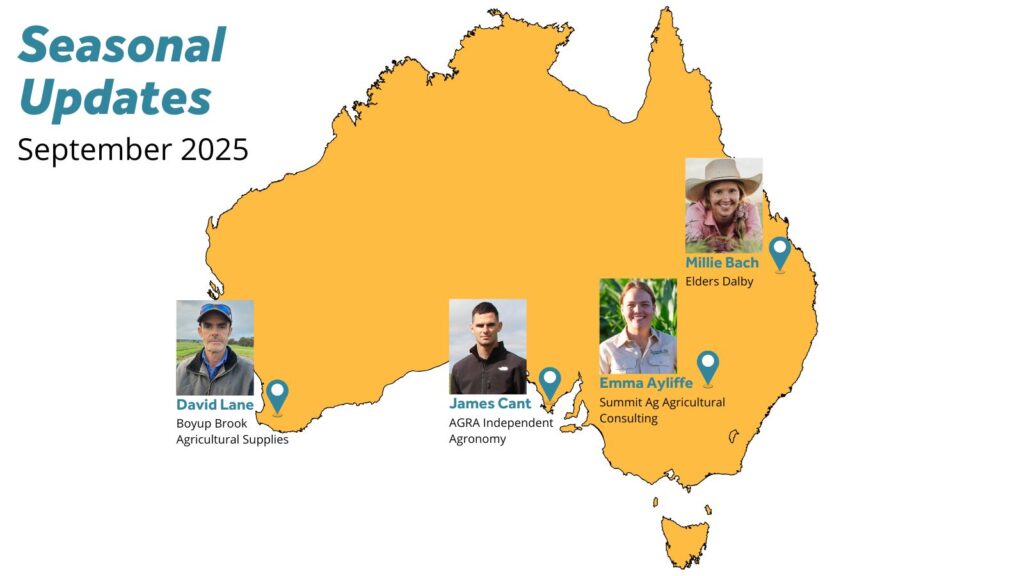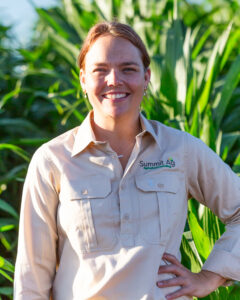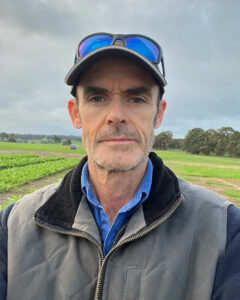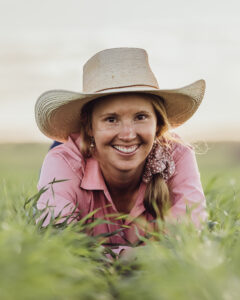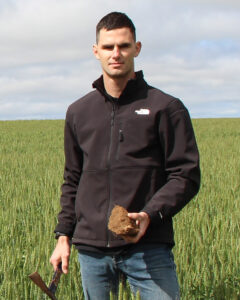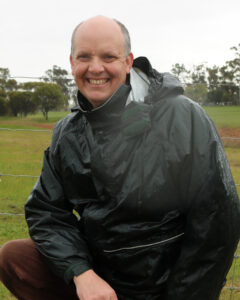From very dry starts to record-breaking wets, this update is another variable story. How is the season shaping up in each region, and what are croppers looking out for?
Four agronomists give us their point of view on the current issues of the season and what growers can be considering: Emma Ayliffe (NSW), Millie Bach (Qld), David Lane (WA) and James Cant (SA).
Emma Ayliffe, Summit Ag Agricultural Consulting, Condobolin and Lake Cargelligo (NSW)
Most people in Emma’s region are running between 15 and 20 days behind normal, though early cereal crops are starting to come out in head. Overall, the low biomass so far has avoided driving the foliar disease pressure. Later crops, she says, are low biomass and “looking thirsty”.
Reflecting on the disease pressure in her area at the moment, Emma says her clients are seeing some of the lowest stripe rust pressure in a long time, even in susceptible varieties or where growers haven’t sprayed. “We’ve got next to nothing in our oats, which is good, and barley is pretty clean,” she says.
When the early break didn’t occur for moisture, some croppers planted barley (after barley) instead of canola – those people have some net blotch pressure, while wheat–wheat rotations are experiencing some yellow leaf spot, Emma says.
For irrigators with highly susceptible varieties, they are applying fungicides but doing it late to extend its efficacy: “The goal now is to push that timing back to get one fungicide on instead of two to protect those money leaves, and then walk away.”
Dryland croppers are keeping a close eye on crown rot now because of its tendency to affect yield in these tight finishes. They are working to identify high-risk locations, but set the expectation of yield if the finish is dry.
Emma cautions that some people put crown rot losses down to the region’s usual tight finishes, but that there is likely more of a relationship to acknowledge between crown rot and lack of yield.
This may take more of a conversation: “We really need to be driving yield to make farms work because it is so expensive to grow these crops. We need to think how we can maximise as much grain as possible for every millimetre of moisture that we get.”
David Lane, Boyup Brook Agricultural Supplies, Brook area (WA)
David’s region has experienced a lot of rain since the last update. The crops that were planted early have been flowering for over an extended period of time already, he says, with canola and cereals on track to yield above average.
Fungicides have been applied earlier than normal this year, with the last fungicides on up to 3 weeks earlier than normal. Crops that have gone in later have had to resort to drones and choppers for spraying because of the wet conditions.
Most barleys in the region are powdery mildew resistant, although David says growers haven’t had much powdery mildew pressure for about four years because of the very dry springs.
Regarding sclerotinia, David has seen more in canola paddocks this year than in a while; he says growers will have to address this for rotations in 2027 – maybe adding another cereal into the rotation, and thinking about canola possibly every third year.
He is also busy monitoring his own trial plots (Boyup Brook Ag Supplies), where he has seen good results from Vortex wheat (LongReach Vortex/LRPB Vortex), Solstice clear field canola (Hyola Solstice CL), Minnie oats, and Foroz pasture (from DLF).
Millie Bach, Elders Dalby, Darling Downs (Qld)
Over in Millie’s patch, everyone’s crops are in and most growers have been fairly lucky with rainfall until now. Another fall now would be well received.
Growers aren’t far off harvesting early crops and are relatively unconcerned disease-wise: “We are looking good, yield- and quality-wise so far,” Millie says.
Wheat is still quite clean, though growers are expecting to see some crown rot expressing and some rust just coming through. Chickpeas likely need more moisture soon but will likely be treated with fungicides in the next month or so.
Some barley has had a second fungicide spray for net blotch and powdery mildew.
Any early chickpeas that were susceptible, like Kyabra, had a spray over them as they started flowering, she says.
People are starting to plant their summer crops, Millie says; cotton and soon mung beans will be going in – but the rotations will depend on each cropper’s levels of loadings in the soil (e.g. fusarium).
There is a bit of worry locally about powdery mildew in mung beans, for instance, because with limited registered products to deal with that. However, some more resistant varieties have been released this year that growers can use to combat that disease.
Millie explains that although resistant varieties of wheat and barley are generally taken up quickly, uptake of mung beans can be slower because of the difficult marketing of different styles. “But growers do swap over when they see the benefit with either yield increases or disease resistance.”
James Cant, AGRA Independent Agronomy, Eyre Peninsula (SA)
From the driest six months on record to record-breaking winter rainfall, James says growers are moving from conservation mode to trying to capitalise on the season.
The benefit of the late start for growers was not having bulky canopies through the winter period, so typical winter diseases weren’t able to establish early and thrive through the wet.
Although there is powdery mildew affecting some of James’s clients, he says it is not well established and is at low levels in the lower canopy.
However, septoria is progressing more quickly than James anticipated: “Usually the hot winds in spring cut it out overnight. But if it continues to stay wet and damp, it’s going to climb up onto the money leaves – the top three – and start causing a yield impact.”
Now that growers have much more moisture and yield potential, James is focusing on helping them protect the asset they have. Fungicides are going out proactively. “I think there is still some unprotected wheat out there that has not had foliar fungicide. It’s a tricky one! Whether you go and spray these large areas, or whether you hold off and wait to see if it rears its head…”
“But we’ve invested so much in these crops already, so fungicides, in comparison, are a cheap investment. Once you’ve got some good yield potential, you have a lot more to lose than saving a few dollars on a fungicide,” James says.
James also mentions that the district is currently keeping a close eye on barley leaf rust at the moment, and that people are watching for botrytis gray mould and ascochyta in lentils. Most lentils didn’t germinate early, so there is less bulk, reducing some of the risk. He says growers will be proactively managing that based on upcoming rain.
Yellow leaf spot is the worst that James has seen for some time: “The dry start and low breakdown of stuff is really hitting the wheat–wheat rotations.” James says it’s a good reminder of why growers in his area have avoided it.
Mark Gibberd, CCDM Director
Mark has been travelling a lot recently collecting samples for study, and reflected on what he’s been seeing: “The level of variability around the country is profound.”
In the West, the rainfall in the last 8 weeks has dramatically shifted the outlook for many growers, who experienced a highly variable establishment but now are looking at the potential of one of the highest yielding years on record.
“I had the pleasure of visiting several farms in and around the Esperance and Munglinup area, and the crops in that region are looking absolutely fantastic,” he says. The dense canopies and excellent growth reflect the significant investment growers have made in inputs such as nitrogen.
However, for Mark this situation prompted reflection on the dichotomy of disease in these types of years where strong yield potentials can come with heightened disease risks.
Old diseases, re-emerging, stealing from the margin
“I was really moved by the fact that I walked into a wheat crop a couple of days ago and went from noticing a significant amount of wheat powdery mildew to observing areas of the crop that also had a head infection,” he says, signalling the severity of the problem.
For growers, dealing with these diseases – whether they are biotrophs like powdery mildew, or necrotrophs like leaf spot type diseases – they consistently reduce margins.
The large inputs that it takes to establish crops are profound, which is echoed in the economic costs and high risks for growers.
Older, well-known diseases are re-emerging under current systems, posing significant threats to productivity and profitability even in what should be exceptional seasons.
Pathogens adapt and respond to host resistance
Mark uses wheat powdery mildew as a current example for this issue, also. Although 5–8 years ago, powdery mildew was an occasional concern, it has shifted to a more dominant problem for growers.
The pathogen is evolving more fungicide resistance, limiting people’s chemical control options. But there is also the possibility the pathogen is evolving to overcome host resistance.
Plant varietal breeders must also consider the delicate balance of types of resistance in their work: sometimes by successfully controlling for necrotrophic diseases (e.g. yellow spot, botrytis), the variety might have less control over minimising resistance to biotrophic diseases (e.g. rusts, mildews).
Over the past two to three years, this trade-off has become increasingly evident. “The pathogens in our production systems are not just responding to fungicides and building that resistance, but also responding to host resistance,” Mark says.
Despite this complex management issue, growers already have access to, for instance, wheat varieties (such as Brumby) that have significant resistance to wheat powdery mildew – and there are more in development.
As well, through GRDC investment in CCDM, scientists are looking at using different forms of resistance from varieties that are more genetically ‘distant’ into breeding programs.
While the problem is pressing, ongoing research and breeding efforts point to the eventual re-establishment of effective host resistance against these pathogens.



